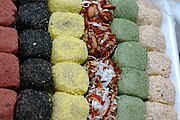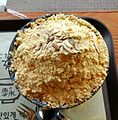Gomul
This article may require copy editing for grammar, style, cohesion, tone, or spelling. (May 2017) |
 Gyeongdan coated with various gomul | |
| Alternative names | Dressing powder |
|---|---|
| Place of origin | Korea |
| Associated cuisine | Korean cuisine |
| Korean name | |
| Hangul | 고물 |
|---|---|
| Revised Romanization | gomul |
| McCune–Reischauer | komul |
| IPA | [ko.mul] |
Gomul (고물) is powdered coatings for tteok (rice cake) such as injeolmi, danja, and gyeongdan, or between-layer fillings for siru-tteok (steamed rice cake).[1][2][3] It is used to improve the appearance and taste of rice cakes. It helps with even cooking of steamed rice cakes, being the less dense layer (compared to the rice flour layer, which tend to turn stickier as steams) through which steam passes more easily.[4]
Gomul is also used to top bingsu (shaved ice). Sometimes, soybean gomul is served with grilled samgyeopsal (pork belly), so that meat is dipped in the soybean powder when eaten.
Varieties and preparation
Red bean or mung bean gomul is used in winter, while soybean or sesame gomul that doesn't spoil as fast is preferred in summer.[4]
Common varieties and their preparation are:[3][4]
- Kong-gomul (콩고물; "soybean powder") – To make the yellow gomul, soybeans are washed, drained, roasted, and mashed with ginger, garlic, and salt. It is then sieved to desired fineness: coarse kong-gomul usually used to coat injeolmi, and coarse kong-gomul to fill and top siru-tteok.
- Pat-gomul (팥고물; "red bean powder") – To make the dark red gomul, unhusked red beans are boiled in three parts water, drained when 80% cooked, and let steam for a long time. When properly cooked without excess moisture, it is salted and mashed.
- Geopipat-gomul (거피팥고물; "hulled red bean powder") – To make the white gomul, red beans (often the black cultivar) are ground in a millstone, soaked in lukewarm water for five to six hours, husked, and steamed in siru. When properly cooked, the beans are salted, mashed, sieved, and pan-fried without oil over a low heat.
- Nokdu-gomul (녹두고물; "mung bean powder") – The pale yellow gomul is made with mung beans in the same way that geopipat-gomul is made.
- Dongbu-gomul (동부고물; "cowpea powder") – The white gomul is made with cowpeas.
- Kkae-gomul (깨고물; "sesame powder") – Sesame is washed, husked, pan-fried without oil, and used whole or coarsely ground with mortar and pestle.
- Heugimja-gomul (흑임자고물; "black sesame powder") – Black sesame is prepared in the same way as for sesame.
- Bam-gomul (밤고물; "chestnut strands/flakes or powder") – Chestnuts are shelled and sliced into thin strands or flakes. Alternatively, they can be cooked, shelled, mashed, and sieved through a coarse strainer into powder.
- Daechu-gomul (대추고물; "jujube strands/flakes") – Jujubes are peeled, and the skin part is sliced into thin strands or flakes.
- Seogi-gomul (석이고물; "rock tripe strands/flakes") – Rock tripe is sliced into thin strands or flakes.
Gallery
-
Siru-tteok filled with pat-gomul (red bean powder)
-
Injeolmi coated with kong-gomul (soybean powder)
-
Injeolmi coated with heugimja-gomul (black sesame powder)
-
Danja coated with bam-daechu-gomul (chestnut and jujube strands)
-
Gyeongdan coated with various gomul
-
Bingsu topped with kong-gomul (soybean powder)
-
Yeot coated with kong-gomul (soybean powder)
-
Kong-gomul (soybean powder) for dipping samgyeopsal (pork belly)
References
- ^ Chun, Hui-jung (2014). Yoon, Ho-mi (ed.). Korean Food Guide 800. Seoul: The Korea Foundation. pp. 36–37. ISBN 89-89782-10-4 – via issuu.
- ^ Shurtleff, William; Aoyagi, Akiko (2012). History of Roasted Whole Soy Flour (Kinako), Soy Coffee, Coffee Alternatives, Problems with Coffee, and Soy Chocolate (1540-2012). Soyinfo Center. p. 5. ISBN 978-1-928914-52-5.
- ^ a b "gomul" 고물. Doopedia (in Korean). Doosan Corporation.
- ^ a b c 신, 미경. "gomul" 고물. Encyclopedia of Korean Culture (in Korean). Academy of Korean Studies. Retrieved 21 May 2017.








